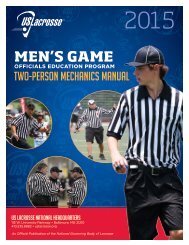BASKETBALL
You also want an ePaper? Increase the reach of your titles
YUMPU automatically turns print PDFs into web optimized ePapers that Google loves.
Rule 4 / Definitions51<br />
Art. 4. A player shall not use the arms, hands, hips or shoulders:<br />
a. To force his way through a screen; or<br />
b. To hold the screener and then push the screener aside in order to maintain<br />
a guarding position relative to his opponent.<br />
Art. 5. It shall be illegal to extend one’s arms fully or partially, other than<br />
vertically, so that the freedom of movement of an opponent is hindered when<br />
contact with the extended arms occurs.<br />
Art. 6. It shall be illegal to extend an elbow(s) and make contact with an opponent<br />
when:<br />
a. Hands are on one’s hips;<br />
b. Hands are held near one’s chest; or<br />
c. Arms are held approximately horizontal to the playing court when not<br />
holding the ball.<br />
Note: These illegal positions are most commonly used when rebounding,<br />
screening or in the various aspects of post play.<br />
Art. 7. The following shall be considered not only excessive, but extreme<br />
swinging:<br />
a. When arm(s) and elbow(s) are swung about while using the shoulders as<br />
pivots, and the speed of the extended arm(s) and elbow(s) exceeds that of<br />
the rest of the body as it rotates on the hips or on the pivot foot; or<br />
b. When the speed and vigor with which the arm(s) and elbow(s) are swung<br />
is such that injury could result if another player were contacted.<br />
Section 19. Holding<br />
Art. 1. Holding is illegal personal contact with an opponent which interferes with<br />
the opponent’s freedom of movement.<br />
Section 20. Inadvertent Whistle<br />
Art. 1. An inadvertent whistle occurs any time an official blows the whistle as an<br />
oversight and does not have a call to make.<br />
Section 21. Incidental Contact<br />
Art. 1. All contact shall not constitute a foul. When 10 players move rapidly in a<br />
limited area, some contact is certain to occur. Incidental contact shall be contact<br />
with an opponent that is permitted and does not constitute a foul.<br />
Art. 2. Contact that is incidental to an effort by an opponent to reach a loose<br />
ball, or contact that results when opponents are in equally favorable positions<br />
to perform normal defensive or offensive movement, should be permitted even<br />
though the contact may be severe or excessive.<br />
Art. 3. Contact that does not hinder the opponent from participating in normal<br />
defensive or offensive movements shall be considered incidental.<br />
Art. 4. A player who is screened within his visual field shall be expected to avoid<br />
contact with the screener by stopping or avoiding the screener.<br />
Art. 5. A player who is screened outside his visual field may make inadvertent<br />
contact with the screener. Such contact shall be incidental, provided that the<br />
screener is not displaced when he has the ball.




